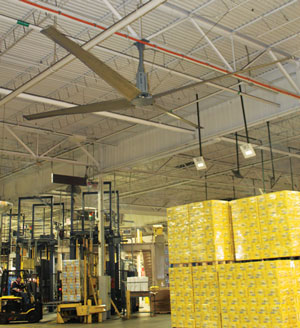Improving Industrial Environments with HVLS Fans
By Andy Olson | November 6, 2012
Category:- HVLS fans can significantly improve employee comfort and health.
- A poor ventilation system can cause a buildup of pollutants within a facility.
- A single HVLS fan can cover an area up to 22,000 sq. ft.
Manufacturing plants, distribution centers, and other large, open warehouse environments with high ceilings have a host of unique design and maintenance challenges. These challenges include air quality, employee safety and comfort, energy costs, and temperature control.
In an effort to mitigate these challenges, high-volume, low-speed (HVLS) fans can be installed as a complement to HVAC systems. HVLS fans can significantly improve employee comfort and health while saving substantial amounts of energy by making existing heating and ventilation systems more efficient in buildings. They can even contribute to earning Leadership in Energy and Environmental Design (LEED®) credits.
Employee Safety, Comfort, Air Quality

HVLS fans can significantly improve employee comfort and health while saving substantial amounts of energy by making existing heating and ventilation systems more efficient in buildings.
Comfort. In the summer, a HVLS fan’s gentle breezes keep employees cool by quickening sweat evaporation.
SSS, SBS, Air Quality. Sweating slab syndrome (SSS) and sick building syndrome (SBS) are two common air quality and employee safety and comfort issues that building managers face.
Sweating slab syndrome occurs when moisture intermittently develops on the surface of an interior concrete slab, such as a warehouse floor. This can increase the slipperiness of the concrete surface, posing a serious safety risk to workers and materials handling operations.
Dew point condensation is a common cause of this moisture accumulation. This happens when warm, humid air enters the structure through open doorways, windows, and vents. As that warm, humid air diffuses throughout the structure, the moisture condenses on a surface that is at or below dew point temperature, which often is the floor surface. When warm, humid air enters a structure, it takes far less time to change the interior air temperature than it does the temperature of the slab. With such a rapid change in conditions, the slab temperature can easily be at or below dew point.
Many large facilities have little air movement. In fact, interior air often is exhausted through roof vents, creating negative pressure in the building. Negative pressure within a structure quickly encourages exterior air and other conditions to enter the building when loading dock doors are open.
SBS is acute health and comfort effects that building occupants experience that appear to be linked to time spent in a building, even though specific causes cannot be identified. In contrast, building-related illnesses are those for which symptoms of diagnosable illness are identified and can be attributed directly to airborne building contaminants.
Though the causes of SBS may be unknown, most affected employees have clinically identifiable symptoms, such as headache, dizziness, and nausea; typically, they feel better soon after leaving the building.
There are a variety of causes for SBS, but they are primarily related to stagnant or dead air. These include poor building design, maintenance, and operation of the structure’s ventilation system. In particular, the ventilation system often is found to be at the heart of the problem, and can itself be a source of irritants. In addition, a poor ventilation system can cause a buildup of pollutants within the facility, in which case the indoor environment’s air quality is much lower than the outdoor air’s.
Interior design factors, such as the arrangement of individual offices and cubicles, may interfere with efficient functioning of ventilation systems also.
Humidity can be a factor. While high relative humidity may contribute to biological pollutant problems, an unusually low level may worsen the effects of mucosal irritants and may even prove irritating itself.
Other contributing elements may be poor lighting and adverse ergonomic conditions, temperature extremes, noise, and psychological stresses that may have both individual and interpersonal impact. The complaints may be localized in a particular area, or may be widespread throughout the building.
HVLS Fans to the Rescue. Although SSS and SBS have different causes, they have similar solutions, at least to some degree. In both cases, increasing air movement and ventilation often provides dramatic relief.
HVLS fans can help reduce or eliminate slab sweating by minimizing ceiling-to-floor temperature differentials and increasing the surface evaporation rate. In addition, commercial dehumidification units can alter the interior building environment to help reduce or eliminate SSS.
Increasing ventilation rates and air distribution often can be a cost-effective means of reducing indoor pollutant levels. HVAC systems should be designed to meet ventilation standards in local building codes; however, many systems are not operated or maintained to ensure that these design ventilation rates are provided.
For SBS, the increased air movement HVLS fans provide helps dissipate humidity and disperse concentrations of airborne contaminants such as chemical fumes, pollens, bioaerosols, or other volatile organic compounds (VOCs.)
Energy Costs, Temperature Control

A single HVLS fan is energy-efficient. A 24-ft.-diameter fan uses 1,500 watts per hour for cooling, and as little as 100 W per hour for destratification
HVLS fans can move large volumes of air. In fact, a single fan can cover an area up to 22,000 square feet and can replace as many as 20 floor fans.
An HVLS fan’s extremely long (up to 24-ft.-diameter) blades spin more slowly than traditional ceiling or ventilating fan blades. The blades are specially designed to capture the maximum amount of air possible and push it softly to the floor.
Destratification. In winter, in a process called destratification, the fans take the warm air created by an HVAC system and pull it down from the ceiling to the floor level, allowing employees to be more comfortable with a lower thermostat setting. During winter months, HVLS fans can reduce energy consumption by up to 30 percent.
Energy Savings. A single HVLS fan is energy-efficient. A 24-ft.-diameter fan uses 1,500 watts per hour for cooling, and as little as 100 W per hour for destratification. This translates to operating costs as low as a few cents per hour.
When used to supplement air conditioning, the fans help lower the perceived temperature, so building operators can raise thermostat set-points. Because this reduces energy costs by roughly 4 percent for every degree the set-point is raised, a 3- to 4-degree increase in the set-point can reduce energy consumption by 12 to 16 percent.
LEED Certification. The energy efficiency and environmental benefits of HVLS fans also have made them a significant potential strategy for earning LEED certification. This is particularly true for buildings with tall ceilings, such as warehouses and distribution centers, where the energy savings can be significant.
In addition, HVLS fans can be run off a single controller that allows for scheduled start/stop times, and the ability to start or stop is based on preset temperature settings. This provides further opportunities for energy cost reductions.
In moderate climates, the cooling properties of HVLS fans can also minimize or even eliminate the need for refrigerant-based thermal comfort systems—another LEED strategy.
Because of these attributes, HVLS fans can contribute to earning LEED credits in a variety of categories, including optimized energy performance; minimum indoor air quality performance; increased ventilation; thermal comfort – design; and innovation in design.
Although no single product can earn a point or meet all of the prerequisite requirements, HVLS fans can be an integral part of an overall strategy to reduce ductwork, installed air-conditioning capacity, and overall material usage in a building.
Improved Employee Relations
While energy savings can be significant and quantifiable, one important benefit manufacturers get from an investment in HVLS fans is hard to put a number on—improved employee relations.
Creating a more comfortable, healthier workplace clearly signals that a company’s management is willing to invest in its greatest asset—its people.

Side by side, we move metal fabrication forward.
FMA unites thousands of metal fabrication and manufacturing professionals around a common purpose: to shape the future of our industry, and in turn shape the world.
Learn More About FMA


